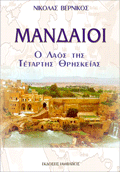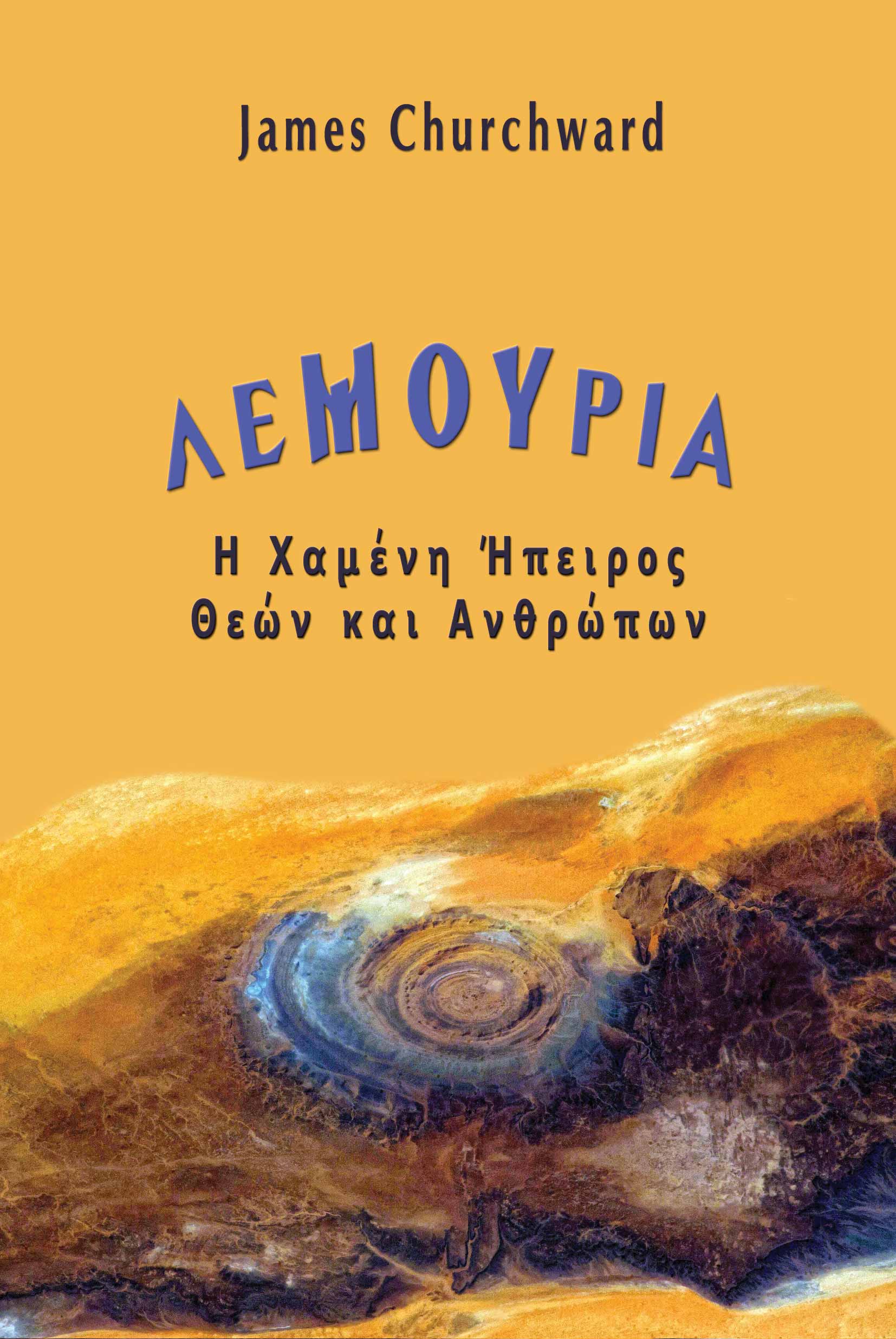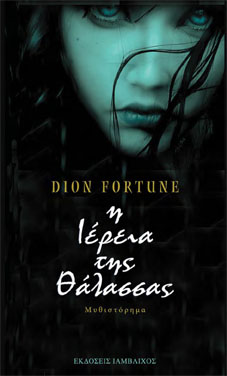Βιβλιοπαρουσίαση
The Mandeans, the People of the Fourth Religion
by Prof. Nicolas Vernicos
Athens, Ed. Iamblichos, 2004, paperbound, pp. 339, illustrations, isbn 960-268-174-8, in Greek.
Address: Ekdoseis IAMBLICHOS,
Valtetsiou 41, Gr-10681 ATHENS, GREECE.
Tel.: +210.3807828.
Fax.: +210.3807435.
e-mail: Iamvlichos
The Mandeans (also known as Subba, Subbiyun, and Nasorai) are, according to the Holy Koran the people of the fourth religion of the book (ahlu I kitab). Numbering about 100.000 people,
the y live in endogamous communities of specialized professional guilds, on the rivers of Southern Iraq and in parts of Iran’s Khouzestan on the banks of river Karoun. There are substantial expatriate communities in Baghdad and abroad (Australia, the United States and Sweden). Since the early 1990’s the Mandeans emerged in the cyberspace with numerous sites and an International «Journal for the Study and Research into the Mandean Culture, Religion and Language», Asuta (2002-2004), freely providing to the public information about their culture along with free English texts of the relations told by Hirmiz bar Anhar and other informants, collected in the early 1930’s by Lady Ethel Stefana Drower and published in 1937. Several English extracts of the Mandean Scriptures are also freely available on the Web, either from Mandeans sites or from sites that specialize in Gnostic religious text, due to the fact that Western academics hold that the Mandeans religion is a Gnostic denomination. In this respect, Prof. N. Vernicos, has provided numerous quotations of Greek Patristic and Gnostic texts, clearly establishing the existence of deeper links between the religious «world views» of the Mandeans and that of the Hellenistic World during the first centuries of our era.
y live in endogamous communities of specialized professional guilds, on the rivers of Southern Iraq and in parts of Iran’s Khouzestan on the banks of river Karoun. There are substantial expatriate communities in Baghdad and abroad (Australia, the United States and Sweden). Since the early 1990’s the Mandeans emerged in the cyberspace with numerous sites and an International «Journal for the Study and Research into the Mandean Culture, Religion and Language», Asuta (2002-2004), freely providing to the public information about their culture along with free English texts of the relations told by Hirmiz bar Anhar and other informants, collected in the early 1930’s by Lady Ethel Stefana Drower and published in 1937. Several English extracts of the Mandean Scriptures are also freely available on the Web, either from Mandeans sites or from sites that specialize in Gnostic religious text, due to the fact that Western academics hold that the Mandeans religion is a Gnostic denomination. In this respect, Prof. N. Vernicos, has provided numerous quotations of Greek Patristic and Gnostic texts, clearly establishing the existence of deeper links between the religious «world views» of the Mandeans and that of the Hellenistic World during the first centuries of our era.
The fact that these Mandeans relations have preserved their original religious ritual content and form, while most European and Arabo-Iranian similar traditional accounts have been secularised and turned into «folklore», make them particularly valuable for students of anthropology, religion, history and ethno-religious identities. Drawing from his personal background and research, Vernicos has attempted a translation of the relations into Modern Greek, using the traditional Anatolian Greek mode of oral history tellers, revealing to the Greek speaking reader a better understanding of archetypal images.
Moreover, a deeper enquiry into the themes, archetypes and shamanic references of the Mandean relations pointed to the fact that the geographical scope of this ethno-religious community (millet) went dwell into the traditions of Central Asia. Examining the claims of the Mandean informers who held that they knew the true stories of Rustam and of his heroic lineage of the Seistani Pehlivan, as well as those of Shah Hizir (Hidr) or of the Simurgh, one realizes that the Mandean religion has an important Iranian background. This comes as an addition to a similar conclusion reached by Lady’s Drower from different material clues.
As a result, Prof. Vernicos, attempts a reconsideration of the Hellenistic cultural presence in Central Asia, and concludes to the existence of a long lasting cultural syncretism between the Iranian and the Hellenistic civilizations. Founded upon the Iranian principles of legitimacy, truth and justice, the Irano-hellenistic world used Greek as a trade language and the civic organization of the Polis for the governance of the local urban centres that were the nodes of the network upon which «global» rulers (shah-in-shahs) governed vast realms. These «basileis basilèôn» promoted transcontinental trade, the emergence of syncretic or new religions (Buddhism), the use of transnational languages (Aramaic, Baktrian, Greek, Pahlavi, etc) and financed the development of brilliant cultures in the Iranian Central Asia and Outer Satrapies (e.g. Gandhara).
Contemporary ethno-cultural identity claims coming from inside and outside the borders of the Iranian World (Iranistan or Iranovitch) are thus of particular interest to students of the eastern realms of this Irano-hellenistic Oikoumenê and of the pre-islamic cults and cultures. This interest is further stimulated from the fact that these «iconoclastic» identity claims are spoken out from serious academic forums in London and California.
CONTENTS (translated from Greek)
Introduction
«ê peri theôn agnôsia, ouk èstin amàthia allà gnôsis.»
First Chapter
The Mandeans the fourth religion of the book (ahlu i kitab).
The Mandean Scriptures.
Language and alphabet.
The basic beliefs of the Mandeans.
«Rasta» the ritual dresses.
Historical facts and testimonials.
Mandeans and Esseneans.
The Mandeans in the United States.
Second Chapter
The Creation, Stars and Symbols.
The creations prayer of the head dress «Klila».
Creation according to the Ginza.
How Hibil Ziwa brought Ruha from the World of Darkness.
The man who wanted to see the face of Sin, the Moon.
Theological arguments.
Creator Angels (dêmiourgoi kai kosmopoioi).
Simon the Mage and the «Ennoia».
The Spirit-Ruha and the Female aspect of God.
The symbolism of the river Jordan.
The catalogue of Names of Chapter 115.
Third Chapter
Mandean texts of Man’s creation.
The creation of Man.
The soul, the spark of life in man.
Sitil, the son of Adam.
Teachings of an Uthra to Adam.
Covered in sleep.
The soul in its multicolor dress.
In the island of Serendip.
The Flood and Noe.
Exodus.
The salvage of the soul.
I said to the Powerful Life.
The daughter of Nebuchadnezzar.
The migration of the Mandeans to the North.
The child conceived on the 29th day of the Moon.
John the Baptist son of Zacharia (Yahya-Yuhanna).
Fourth Chapter
Extracts from the Haran Gawaitha.
The bridge of Shuster.
How Dana Nukh went to the seventh heaven.
What do Hindus see while in trance.
How evil spirits abuse the death.
People who returned from the deaths.
The end of creation, the rule of the Sun – Samish.
Fifth Chapter
Pishtadi and Pehliva: founders and heroes, history of the Pishtadi dynasty (an enquiry into the Iranian roots of Mandaism).
The history of the generation of the Seistani Pehlivans.
Seistan (Drangianê): the homeland of Zal and Rustam.
The lakes of Seistan, the «Hamouns» and the river Helmend.
An American-Iranian archaeological research at Kuh-e-Khawjyeh (1995-2000).
The Mandean story of Rustam.
Sixth Chapter
Relations and beliefs.
Metanthropos or Hieranthropus (beyond Insan ul Kamil).
The Kaftar.
Stories of Shaik Zibid.
Hirmiz Shah.
The Simurgh.
Hirmiz Shah and the Simurgh.
Kanshi u Zahla: sweeping and cleaning.
The Haunted.
When a deadly plague befell upon Shuster.
The fire-worshipper mage and Adam Bul Faraz.
The strange story of the sons of Bibi.
The capacity to see spirits.
Seventh Chapter
Historical Chronicles, a into the eastern realms.
Ancient Hellenic and Iranian world.
The Iranian world and the Hellenistic cultural syncretism.
The Mauryas (317-250 B.C.)
The Parthians after 250 B.C.
Independent Baktria after 250 B.C.
Balkh: the Mother of Cities, Baktrianê and Margianê.
Parthian king Mithradates Philhellên (171-138 B.C.)
The Skythian Saka and the Indo-Hellenic Kingdoms after 150 B. C.
In «Our Oeucumene», the Eastern World after 30 A.D.
The Kushanas.
The Religions of the Kushanas-Yueh-Chi.
The Sassanids (226-636 A.D.)
The Hephtalides (420-570) and the end of the Hellenistic influences.
The ancestors of the Afghani.
Afghanistan an ancient land (by Fauzia Sharifi-Assifi).
The First Monotheistic Religion. Claiming of an ethnoreligious identity (by Noorbakhsh Rahim Zadeh.)
Epilogue
Friday April 25, 2003.
«Tab taba Itabia» (Ginza Rba, chapter 170)
Mandean Terms and Glossary.
Bibliography, URLS and Readings.
{Aineitai tê Zôê! E Zôê nikà eis pànda ta èrga!}






